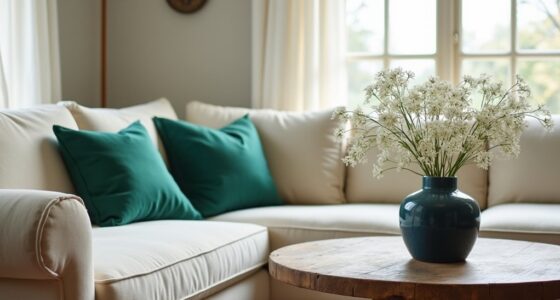When choosing trim and ceiling colors that work, consider your room’s style and the mood you want to create. High contrast creates a bold look, while matching or low-contrast colors for the trim and walls offer a more seamless, tranquil feel. Whites or off-whites are common for ceilings, helping open the space. Think about how natural and artificial light interact with your color choices. To discover effective combinations that suit your space, keep exploring the essentials.
Key Takeaways
- Opt for high-contrast colors like white trim with darker walls to create definition.
- Use neutral or light ceiling colors, such as white or soft hues, to make spaces feel larger and brighter.
- Match or closely coordinate ceiling and wall colors for a modern, seamless look.
- Choose semi-gloss or high-gloss finishes for trim to enhance contrast and ease cleaning.
- Consider natural and artificial lighting to see how colors and finishes will interact in the space.

Selecting the right trim and ceiling colors can considerably influence the overall look and feel of your space. When you choose colors thoughtfully, you can create a room that feels cohesive, balanced, and inviting. One key aspect to contemplate is color contrast. High contrast between trim and wall colors can add definition and highlight architectural details, making your space look more dynamic. For example, pairing crisp white trim with darker wall shades creates a striking visual impact. Conversely, low contrast combinations, like matching the trim color closely to the wall hue, offer a softer, more seamless appearance that can make a room feel larger and more tranquil.
Your choice of paint finish also plays a significant role in how your trim and ceiling colors look and perform. For trims and moldings, a semi-gloss or high-gloss finish is often preferred because it reflects light well and is easier to clean. This finish accentuates the trim’s details and creates a subtle contrast with matte or eggshell walls. For ceilings, a flat or matte finish works best since it minimizes imperfections and provides a smooth, non-reflective surface that enhances the room’s overall ambiance. The paint finish not only affects the aesthetic but also the durability, so pick finishes that suit the function of each surface.
Choosing semi-gloss or high-gloss finishes for trim enhances durability and highlights details.
When selecting ceiling colors, most people stick with white or off-white shades because they open up the space and bounce light around the room. But don’t be afraid to experiment with subtle hues like soft blues or warm beiges if you want a cozy, personalized feel. The key is to guarantee your ceiling color complements your wall and trim choices. If your walls are a bold or dark color, a lighter ceiling can prevent the space from feeling too enclosed. Conversely, matching or closely aligning the ceiling color with the wall hue can create a sophisticated, uniform look, especially in modern or minimalist designs.
In addition, understanding how zodiac sign personality traits influence color preferences can help tailor your choices to reflect your individual style and emotional needs. When considering your trim and ceiling colors, think about the mood you want to set and how the colors interact with natural and artificial light throughout the day. Keep in mind that the paint finish amplifies these effects—glossy trims will catch more light and stand out more, while matte or satin finishes provide a softer transition. The right combination of color contrast and paint finish ensures your trim and ceiling contribute beautifully to your room’s overall aesthetic, making your space feel thoughtfully designed and visually appealing.
Frequently Asked Questions
How Do I Choose Trim and Ceiling Colors for Small Rooms?
To choose trim and ceiling colors for small rooms, opt for light shades to make the space feel larger. Use color contrast thoughtfully; a slightly darker ceiling can add depth, while matching trim to wall color creates a seamless look. Consider paint sheen—satin or semi-gloss on trim adds dimension, and matte on ceilings softens the space. These choices help balance brightness and create a cozy, visually appealing room.
Can I Use Different Trim Colors in Different Rooms?
Think of your home as a wardrobe—mixing different accessories creates unique style. Yes, you can use different trim colors in different rooms. It adds decorative trim accents and enhances each space’s personality. To keep things cohesive, consider ceiling paint techniques that tie the rooms together. Just make certain the contrast complements the overall design, making each room stand out while still feeling connected.
What Are the Best Ceiling Colors for High Ceilings?
For high ceilings, opt for light, neutral ceiling colors like soft whites or pale shades to make the space feel cozy and balanced. Your ceiling texture can add visual interest—smooth finishes work well for modern looks, while textured surfaces create depth. Choose trim material that complements your ceiling color, such as painted wood or plaster, to enhance the overall aesthetic and create a seamless, polished look that doesn’t overwhelm the room.
How Do Lighting Conditions Affect Trim and Ceiling Color Choices?
Lighting conditions greatly influence your trim and ceiling color choices. Natural light brightens a space and can make colors appear lighter or cooler, so opt for softer or warmer tones if the room gets plenty of sunlight. Artificial lighting, like warm bulbs, can warm up colors, while cool bulbs make them feel crisper. Consider how both lighting types change throughout the day to select colors that stay balanced and appealing.
Are There Color Combinations to Avoid for Trim and Ceilings?
You should avoid color clashes and outdated palettes for trim and ceilings. Bright whites with bold, dark colors can create jarring contrasts, while mixing warm and cool tones may result in visual discord. Steer clear of overly vibrant or neon shades that clash with your wall hues. Instead, prioritize harmonious combinations that enhance your space’s style, ensuring your trim and ceiling colors complement rather than compete, creating a cohesive, inviting atmosphere.
Conclusion
Choosing the right trim and ceiling colors can truly transform your space. Remember, a well-coordinated palette can make your room feel larger, brighter, and more inviting. Did you know that 85% of homeowners report feeling happier in rooms with thoughtfully chosen color schemes? So don’t be afraid to experiment and trust your instincts. With a little effort, you’ll create a stunning, cohesive look that reflects your style and enhances your everyday living.









